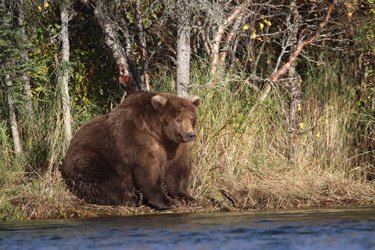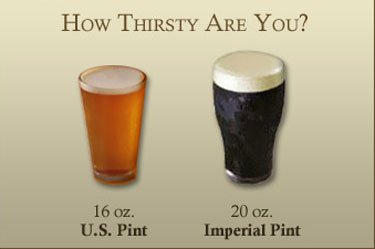Category Archive 'Measure'
05 Oct 2021


High Country News reports on a clever method of finding out.
Brown bears are fattening up for winter hibernation in Alaska’s Katmai National Park and Preserve. And starting today, thousands of viewers from around the world will tune in for Fat Bear Week to watch the bears gobble fish from the Brooks River, estimate how well they’re packing on the pounds, and then vote for the portliest in a single elimination bracket.
But just how fat are those fat bears? A winner will be crowned Oct. 5, but webcam viewers — almost 650,000 cast votes last year — and actual visitors — 15,000 came to Brooks Falls to see the bears in 2019 — are just guesstimating. But there’s hope for achieving greater accuracy: GIS specialist Joel Cusick is pioneering a new technique for calculating the bears’ weight that has broader implications for noninvasive wildlife research.
The idea came to Cusick, who works for the National Park Service in Alaska, in 2018, while he was working on mapping and surveying at Katmai. A terrestrial lidar scanner, which uses lasers to determine distance and other measurements, was on hand to measure buildings. That’s the device traditional civil engineers use, but when Cusick wandered down to Brooks Falls and stood on a viewing platform 300 feet away from the bears, inspiration hit. He thought: Why not use the scanner to measure a bear’s surface volume instead?
“I got a laser return from the butt of Otis, one of the more famous brown bears up there,” Cusick said. “I thought, ‘Wow, this just might work.’”
Lidar, which stands for “light detection and ranging,” emits beams of light to measure three-dimensional objects or areas. When light waves hit an object, they bounce off and return to the sensor. Computers then use the speed of light to calculate the distance between the sensor and all the points. That figure is then processed using software that can model a three-dimensional object. Scanners have become standard technology that is deployed from the ground, the sky and satellites to measure vegetation growth. Now, they’re being used to measure bears’ length, height and girth.
RTWT
04 Oct 2021


From The World in the Balance: The Historic Quest for an Absolute System of Measurement by Robert Crease (2011), quoted in the London Review of Books.
The geeks at the Massachusetts Institute of Technology are fond of merry japes, locally known as ‘hacks’. One of the more memorable happened one night in October 1958 when an MIT fraternity had the idea of initiating new members by making them measure a bridge over the Charles River connecting the Cambridge campus with Boston. Crossing the bridge was often a wet, windy and unpleasant business and it was thought that students returning at night from downtown would like to know, by visible marks and with some precision, how far they still had to go. The older fraternity brothers decided to use one of the new pledges as a rule, and selected Oliver R. Smoot, the shortest of the lot at 5ft 7in. The other pledges laid Smoot out at one end of the bridge, marked his extent with chalk and paint, then picked him up and laid him down again, spelling out the full measurement every ten lengths, and inscribing the mid-point of the bridge with the words ‘halfway to Hell’. In this way, it was determined that the span was 364.4 smoots long, ‘plus or minus one ear’ (to indicate measurement uncertainty).
The hack was too good to let fade away, so every now and then the fraternity makes its pledges repaint the markings. You might think this isn’t the sort of vandalism the police would tolerate, but they do. The smoot markings soon became convenient in recording the exact location of traffic accidents, so (as the story goes) when the bridge walkways needed to be repaved in 1987, the Massachusetts Department of Public Works directed the construction company to lay out the concrete slabs on the walkway not in the customary six-foot lengths but in shorter smoot units. Fifty years after the original hack, the smoot markers have become part of civic tradition: the City of Cambridge declared 4 October 2008 ‘Smoot Day’. MIT students ran up a commemorative plaque on a precision milling machine and created an aluminium Smoot Stick which they deposited in the university’s museum as a durable reference standard: the unit-smoot is now detached from the person-Smoot. Through the legions of MIT graduates driving global high-tech culture, the smoot has travelled the world. If you use Google Earth, you can elect the units of length in which you’d like distances measured: miles, kilometres, yards, feet – and smoots.
RTWT
01 Oct 2014


I’d prefer champagne to Guinness.
The Guardian reports (along with some major up-sucking to the poofters) a token expression of actual conservatism by Bristish PM David Cameron.
Schools should teach pupils mainly in imperial and not metric measurements, David Cameron has said.
Four decades since metres and litres replaced yards and pints on the curriculum, the prime minister suggested he would prefer to see a return to the old system.
“I think I’d still go for pounds and ounces, yes I do,†Cameron told BBC2’s Newsnight when asked which should be taught predominantly.
The present curriculum, which Tory ministers have said they will skew towards imperial measures, requires only that pupils “understand and use approximate equivalences between metric units and common imperial units such as inches, pounds and pintsâ€.
———————–
But, restoring Imperial measure, and particularly restoring the Imperial pint, is nonetheless a highly worthy goal, as Simon Berry once argued in the Spectator.
The imperial pint makes for a perfect-sized bottle. You get four proper-sized glasses from it — as opposed to six from a bottle, or three from a half-bottle. Champagne is designed to be shared, preferably with one other person. Six glasses between two are — if you’re carrying on to another bottle with dinner — too much. However, three glasses are certainly too little to share between two people: one for me, one for you, and a dribble for us both to finish? That’s just mean, and the one thing you should never associate with champagne is meanness.
The imperial pint was Churchill’s favourite way of drinking his beloved Pol Roger — there’s even one proudly displayed in the Cabinet War Rooms (which we supplied from the Berry Bros & Rudd private reserves). I also associate the pint with Duff Cooper. In 1953, in his memoir Old Men Forget, he writes: ‘I ordered an imperial pint of champagne, that admirable measure which like so many good things has disappeared from the world.’ He is remembering a bleak Sunday night in the early stages of the first world war, when he was dining alone at his club, due to return to his army training camp and overcome by ‘a great cloud of depression’. But the pint bottle and a copy of Through the Looking-Glass accompanied him through his dinner, and ‘as by enchantment my melancholy left me and I knew that I should not be unhappy again’.
Hat tip to James Delingpole [Facebook].
/div>

Feeds
|






